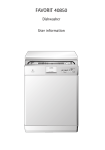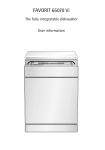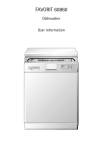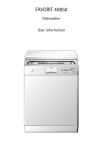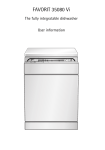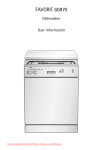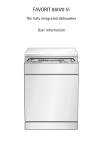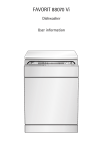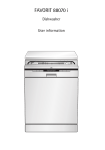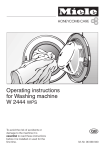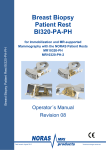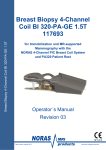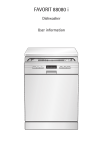Download Electrolux 64570 Vi Dishwasher User Manual
Transcript
FAVORIT 64570 Vi The fully integratable dishwasher User information Dear Customer, Please read this user information carefully and keep it to refer to later. Please pass the user information on to any future owner of the appliance. 1 3 2 2 The following symbols are used in the text: Safety instructions Warning! Information that affects your personal safety. Important! Information that prevents damage to the appliance. Useful tips and hints Environmental information Contents Operating Instructions . . . . . . . . . . . . . . . . . . . . . . . . . . . . . . . . . . . . . 4 Safety . . . . . . . . . . . . . . . . . . . . . . . . . . . . . . . . . . . . . . . . . . . . . . . . . . . . . . . . . 4 Diagram of Appliance . . . . . . . . . . . . . . . . . . . . . . . . . . . . . . . . . . . . . . . . . . . 6 Control Panel . . . . . . . . . . . . . . . . . . . . . . . . . . . . . . . . . . . . . . . . . . . . . . . . . . 6 Prior to Using for the First Time. . . . . . . . . . . . . . . . . . . . . . . . . . . . . . . . . . 8 Setting the Water Softener . . . . . . . . . . . . . . . . . . . . . . . . . . . . . . . . . . . . . . . 8 Adding dishwasher salt . . . . . . . . . . . . . . . . . . . . . . . . . . . . . . . . . . . . . . . . . . . 10 Filling Up with Rinse Aid. . . . . . . . . . . . . . . . . . . . . . . . . . . . . . . . . . . . . . . . . . 11 Activating/deactivating the acoustic signal . . . . . . . . . . . . . . . . . . . . . . . . . . 13 In daily use . . . . . . . . . . . . . . . . . . . . . . . . . . . . . . . . . . . . . . . . . . . . . . . . . . . . Loading cutlery and dishes . . . . . . . . . . . . . . . . . . . . . . . . . . . . . . . . . . . . . . . . Adjusting the height of the upper basket. . . . . . . . . . . . . . . . . . . . . . . . . . . . Adding Detergent. . . . . . . . . . . . . . . . . . . . . . . . . . . . . . . . . . . . . . . . . . . . . . . . Using 3in1 detergents . . . . . . . . . . . . . . . . . . . . . . . . . . . . . . . . . . . . . . . . . . . . Selecting the dishwashing cycle (Cycle Table) . . . . . . . . . . . . . . . . . . . . . . . . Starting a dishwashing cycle . . . . . . . . . . . . . . . . . . . . . . . . . . . . . . . . . . . . . . Setting the Delay Timer. . . . . . . . . . . . . . . . . . . . . . . . . . . . . . . . . . . . . . . . . . . Switching off the dishwasher. . . . . . . . . . . . . . . . . . . . . . . . . . . . . . . . . . . . . . 14 14 18 19 20 21 22 22 23 Care and cleaning . . . . . . . . . . . . . . . . . . . . . . . . . . . . . . . . . . . . . . . . . . . . . . 23 What to do if... . . . . . . . . . . . . . . . . . . . . . . . . . . . . . . . . . . . . . . . . . . . . . . . . . 26 Remedying small malfunctions . . . . . . . . . . . . . . . . . . . . . . . . . . . . . . . . . . . . 26 If the Dishwashing Results are not Satisfactory. . . . . . . . . . . . . . . . . . . . . . . 28 Disposal . . . . . . . . . . . . . . . . . . . . . . . . . . . . . . . . . . . . . . . . . . . . . . . . . . . . . . . 29 Technical data. . . . . . . . . . . . . . . . . . . . . . . . . . . . . . . . . . . . . . . . . . . . . . . . . . 29 Notes for Test Institutes . . . . . . . . . . . . . . . . . . . . . . . . . . . . . . . . . . . . . . . . . 30 Installation and connection instructions. . . . . . . . . . . . . . . . . Scope of use . . . . . . . . . . . . . . . . . . . . . . . . . . . . . . . . . . . . . . . . . . . . . . . . . . . . General . . . . . . . . . . . . . . . . . . . . . . . . . . . . . . . . . . . . . . . . . . . . . . . . . . . . . . . . Water Supply Connection . . . . . . . . . . . . . . . . . . . . . . . . . . . . . . . . . . . . . . . . . Water Outlet Hose Connection. . . . . . . . . . . . . . . . . . . . . . . . . . . . . . . . . . . . . Installing and fitting the hinged door. . . . . . . . . . . . . . . . . . . . . . . . . . . . . . . Electrical Connection. . . . . . . . . . . . . . . . . . . . . . . . . . . . . . . . . . . . . . . . . . . . . 32 32 32 33 33 34 39 Warranty conditions . . . . . . . . . . . . . . . . . . . . . . . . . . . . . . . . . . . . . . . 41 Service and Spare Parts . . . . . . . . . . . . . . . . . . . . . . . . . . . . . . . . . . . 43 3 Operating Instructions 1 Safety Prior to using for the first time • Follow the ”Instructions for installation and connection”. Correct Use • The dishwasher is only intended for washing domestic dishes. • Additions or modifications to the dishwasher are not permitted. • Use only special salt, detergent and rinse aid suitable for domestic dishwashers. • Do not put any solvents in the dishwasher. This could cause an explosion. Child Safety • Keep packaging away from children. There is a risk of suffocation. • Children often do not recognise the hazards associated with electrical appliances. Don’t allow children to use the dishwasher unsupervised. • Make sure that children and pets don’t climb into the dishwasher. Could endanger life! • Dishwasher detergents can cause chemical burns to the eyes, mouth and throat. Could endanger life! Comply with the safety instructions of the dishwasher detergent manufacturer. • The water in the dishwater is not for drinking. Risk of chemical burns. 4 General Safety • Repairs to the dishwasher are only to be carried out by qualified/authorised service engineers. • When the dishwasher is not being used, switch it off and shut off the water tap. • Never unplug the appliance by pulling on the cable. Always pull the plug. • Ensure that the door of the dishwasher is always closed when it is not being loaded or unloaded. In this way you will avoid anybody tripping over the open door and hurting themselves. • Never sit or stand on the open door. • If the dishwasher is located in a room where there may be a frost, remove the connection hose from the tap after each use of the dishwasher. Risk of frost • If the appliance is exposed to temperatures below freezing while connected, it must be correctly emptied by the Customer Service Centre. • When being delivered from the factory, there is no danger of the appliance freezing! 5 Diagram of Appliance Ceiling spray arm Upper basket spray arm and lower spray arm Filters Detergent Dispenser Rinse aid dispenser Control panel Rating plate Dispenser for dishwascher salt Control Panel ON/OFF button To use the appliance, always open the dishwasher door first. The ON/OFF button is used to turn the dishwasher on and off. 6 Set delay timer 1 Multi-display Programme buttons 2 Select 3 in1 function 3 Control indicators Function buttons The Programme buttons are used to select the desired dishwashing cycle. Function buttons: In addition to the pre-set dishwashing cycle, the following functions can also be set using these buttons: Function button 1 Sets the water softener Function button 2 Activates/deactivates rinse aid dispenser Function button 3 Activates/deactivates the acoustic signal The multi-display can indicate: – the level of hardness to which the water softener is set. – whether the rinse aid dispenser has been activated/deactivated. – whether the acoustic signal has been activated/deactivated. – the start delay that has been set. – the estimated time remaining for the current dishwashing cycle. – what type of error has occurred with the dishwasher. The control indicators have the following meanings: a 1) Refill with dishwasher salt b 1) Refill with rinse aid 1) These control indicators are never illuminated while a dishwashing cycle is running. 7 Prior to Using for the First Time 1. Set the water softener 2. Fill up with dishwasher salt 3. Fill up with rinse aid 3 3 3 3 If you wish to use 3in1 detergent, do the following: – First read the section “Using 3in1 detergents”. – Switch on the dishwasher, press the 3in1 button. The button indicator lights up: 3in1 function is selected. As a result – there is no need to fill up with dishwasher salt or rinse aid. – there is no need to set the water softener. – there is no need to set the rinse aid dispenser. – Before the start of the dishwashing cycle put 3in1 detergent in the detergent dispenser. Once this additional function has been selected, it remains activated for all further dishwashing cycles until it is cancelled by pressing the button again. The lengths of the wash cycles given in the cycle table can be changed if this additional function is used. When changing from 3in1 detergent tablets to normal detergent, it is most important to observe the last 3 points in the section “Using 3in1 detergents”. Setting the Water Softener 3 3 8 To avoid scale deposits on the dishes and in the dishwasher, the dishes must be washed with soft water, i.e. water with a low lime content. The water softener must be set according to the table to the water hardness in the area where you live. Your local water company will be able to give you information about the water hardness in your area. 1. Press the ON/OFF button. If the LED indicator of only one programme button is illuminated, this wash programme has been activated. The wash programme must be deselected: Press function buttons 2 and 3 simultaneously for approx. 2 seconds. The LED indicators of all the buttons that can be selected will illuminate. Exception: The 3in1 button will only illuminate if the function has been activated. 2. Press function buttons 2 and 3 simultaneously and hold them down. The LED indicators for function buttons 1 to 3 will flash. 3. Press function button 1. The LED indicator for function button 1 will flash. The multi-display will indicate the hardness setting. 4. Pressing function button 1 increases the hardness setting by 1. (Exception: hardness setting 1 follows hardness setting 10). 5. When the hardness setting is correct, press the ON/OFF button. The hardness setting is now saved. If the water softener is set electronically to “1”, this switches off the control indicator for dishwasher salt. Water hardness 1) 2) Adjusting the hardness setting Indication on the multi-display in °fh ) in °dh ) 90 - max. 125 76 - 89 65 - 75 51 - 64 40 - 50 33 - 39 26 - 32 19 - 25 07 - 18 51 - max. 70 43 - 50 37 - 42 29 - 36 23 - 28 19 - 22 15 - 18 11 - 14 4 - 10 103) 9 8 7 6 5 4* 3 2 10L . 9L 8L 7L 6L 5L 4L 3L 2L below 7 below 4 1 no salt necessary 1L 1) (°fh) French degree, measure of the hardness of water 2) (°dh) German degree, measure of the hardness of water 3) On this setting the length of the dishwashing cycle may be slightly longer. *) factory setting 9 Adding dishwasher salt 3 3 10 To decalcify the water softener, it must be filled up with dishwasher salt. Use only special salt suitable for domestic dishwashers. If you do not use 3in1 detergent, fill up with dishwasher salt: – Before using the dishwasher for the first time. – When the control indicator for dishwasher salt is illuminated on the control panel. 1. Open the door and remove the lower basket. 2. Screw open the lid on the salt dispenser by turning it anti-clockwise. 3. Only when using the dishwasher for the first time: Fill the salt dispenser with water. 4. Fill the dispenser with dishwasher salt; the capacity of the dispenser is approx. 1.0-1.5 kg, depending on the size of the grains. Do not overfill the dispenser. If water overflows when filling up with dishwasher salt, this is completely harmless. 5. Clean away any salt remnants from the dispenser opening. 6. Screw the lid back on in a clockwise direction. 7. Run a dishwashing cycle after filling the salt dispenser with dishwasher salt. This will wash away salt water and salt crystals that have been spilt. Depending on the size of the salt granules, it can take several hours for the salt to dissolve in the water and for the control indicator for dishwasher salt to go out. Filling Up with Rinse Aid Rinse aid causes the rinse water to flow easily from the crockery leaving gleaming dishes and glassware. If you do not use 3in1 detergent, fill up with rinse aid: – Before using the dishwasher for the first time. – When the control indicator for rinse aid is illuminated on the control panel. Use only special rinse aid for dishwashers. 1. Open the door. The rinse aid compartment is located on the inside of the dishwasher door. 2. Press the release button on the rinse aid compartment. 3. Open the cover. 4. Pour rinse aid in slowly right up to the broken “max” line; this corresponds to a volume of approx. 140 ml when full. 5. Press the lid shut until it clicks into place. 6. Wipe up any spilt rinse aid with a cloth. Otherwise there will be too much foam when rinsing. 11 Setting the Amount of Rinse Aid Required 3 Only change the amount dispensed, if smears, milky spots (reduce the amount) or dried on water spots (increase the amount) can be seen on glasses and dishes. (See section “If dishwashing results are not satisfactory”.) The dosage can be set from 1-6. The dosage is pre-set to “4” in the factory. 1. Open the dishwasher door. 2. Press the release button on the rinse aid compartment. 3. Open the cover. 4. Set the dosage level. 5. Press the lid shut until it clicks into place. 6. If rinse aid has leaked out, wipe it away with a cloth. Activating/Deactivating the Rinse Aid dispenser 3 If the 3 in1 button is pressed, you do not need to deactivate the rinse aid dispenser. 1. Press the ON/OFF button. If the LED indicator of only one programme button is illuminated, this wash programme has been activated. The wash programme must be deselected: Press function buttons 2 and 3 simultaneously for approx. 2 seconds. The LED indicators of all the buttons that can be selected will illuminate. Exception: The 3in1 button will only illuminate if the function has been activated. 2. Press function buttons 2 and 3 simultaneously and hold them down. The LED indicators for function buttons 1 to 3 will flash. 3. Press function button 2. The LED indicator for function button 2 will flash. The multi-display will indicate the current setting: 12 0d Rinse aid dispenser is deactivated 1d Rinse aid dispenser is activated (factory setting) 4. Pressing function button 2 activates and deactivates the rinse aid dispensing function. 5. Once the multi-display is indicating the required setting, press the ON/ OFF button. The setting is now saved. Activating/deactivating the acoustic signal 3 In addition to the optical display (e.g. indicating the end of the cycle, errors) you can also choose to set an acoustic signal. 1. Press the ON/OFF button. If the LED indicator of only one programme button is illuminated, this wash programme has been activated. The wash programme must be deselected: Press function buttons 2 and 3 simultaneously for approx. 2 seconds. The LED indicators of all the buttons that can be selected will illuminate. Exception: The 3in1 button will only illuminate if the function has been activated. 2. Press function buttons 2 and 3 simultaneously and hold them down. The LED indicators for function buttons 1 to 3 will flash. 3. Press function button 3. The LED indicator for function button 3 will flash. The multi-display will indicate the current setting: 0b Acoustic signal deactivated 1b Acoustic signal activated (ex-factory setting) 4. Pressing function button 3 will change the setting. 5. Once the multi-display is indicating the required setting, press the ON/ OFF button. The setting is now saved. 13 In daily use Loading cutlery and dishes 1 Sponges, cleaning cloths and any other objects that can absorb water must not be washed in the dishwasher. Plastic and Teflon-coated dishes and pans tend to retain water droplets. These dishes and pans therefore do not dry as well as those made of china and stainless steel. For washing in the dishwasher, the following cutlery/dishes/pots and pans are not suitable: are of limited suitability: • Cutlery with wooden, horn, china or mother of pearl handles • Plastic items that are not heat resistant • Older cutlery with cement that is sensitive to temperature • Dishes or cutlery with glued parts • Pewter or copper items • Lead crystal glass • Steel items that rust • Wooden boards/platters • Items made from synthetic materials • Only wash stoneware in the dishwasher if it is specifically marked by the manufacturer as being dishwasher-safe. • Glazed patterns may fade if washed very frequently in the dishwasher. • Silver and aluminium parts have a tendency to discolour during washing. Food remains, e.g. egg white, egg yolk and mustard often cause discoloration and staining on silver. Therefore always clean food residues from silver immediately, if it is not to be washed straight after use. • Glass can become dull after a large number of washes. • Before loading the dishes, you should: – Remove the worst of the food residues. – Soak pans with burnt-on food residues. • When loading the dishes and cutlery, please note: – Dishes and cutlery must not impede the rotation of the spray arms. – Load bowls, cups, glasses, pans, etc. with the opening downwards so that water cannot collect in them – Dishes and items of cutlery must not lie inside one another or cover one another – To avoid damage to glasses, they must not touch one another – Don’t put small items (e.g. lids) in the baskets for the dishes, but in the cutlery basket, so that they can’t fall through the holes. 14 Loading cutlery 1 1 Warning: Sharp knives and other items of cutlery with sharp edges must be laid in the cutlery rack or in the upper basket to avoid the risk of injury. To ensure that all items of cutlery in the cutlery basket can be reached by the water, the cutlery inserts should be inserted and where possible the cutlery placed handle downwards in the cutlery basket. Exceptions to this are cutlery items with very narrow handles that could go through the cutlery basket and block the spray arm. For larger utensils, such as whisks, one half of the cutlery grid can be left off. So that spoons don’t lie inside one another, arrange them alternately with other cutlery items. The cutlery basket consists of two parts that can be taken apart. You can gain more room in the lower basket in this way. 1. To separate, push them horizontally in opposite directions and pull apart. 2. To put together, do this in reverse. 15 Pots, Pans, Large Plates Load large and heavily soiled dishes in the lower basket. The plate rack running right to left at the front right-hand side is most suitable for small flat plates with a diameter of 170-210 mm. A serving plate can be placed in front of the cutlery basket. To make it easier to load larger dishes, all rear plate rests in the lower basket can be folded down. Folding down the right plate rest makes a second plate rest that is particularly suitable for deep plates or bowls. 1. Lift the two plate racks slightly at the back and fold them simultaneously inwards making them cross over one another. The left plate rest can be folded down and the width can be adjusted. 1. To fold them down, lift the two plate racks slightly at the back and fold them inwards making them cross over one another. 2. To set the width, pull the right-hand plate rest upwards at the back until it disengages, then pull it towards the back out of the front guide. 3. Insert the plate rest in the other guide and press it down at the back until it snaps in. 16 Cups, Glasses, Coffee Service Load smaller, fragile crockery and long, sharp cutlery in the upper basket. Adjustable cup racks • Arrange items of crockery on and under the folding cup racks so that they are offset from each other and water can reach all items. • The cup racks can be folded up out of the way for tall crockery items. • The cup racks can also be fixed in an intermediate position. Lay or hang glasses with stems in the slots in the cup racks. Glass holders For glasses with stems and tall cylindrical glasses, fold up the glass holder. ( Top picture) To unload or when not needed, fold the glass holders back to the right. (Middle picture) Glasses can also be placed over the bars pointing up. (Bottom picture) 17 Adjusting the height of the upper basket Maximum height of dishes in the 3 3 18 Upper basket Lower basket with upper basket raised 19 cm 32 cm with upper basket lowered 21 cm 30 cm The height of the baskets can also be adjusted when they are loaded. Raising/Lowering the Upper Basket 1. Pull out the upper basket completely. 2. Raise the upper basket as far as it will go and then lower it vertically. The upper basket will latch into the lower or the upper position. Before using the dishwasher, check that the spray arms can turn freely. Maximum plate sizes, Maximum plate sizes, upper basket in upper position upper basket in lower position Adding Detergent 1 Detergents remove the dirt from dishes and cutlery. The detergent must be added before the cycle starts. Only use detergent intended for domestic dishwashers. The detergent compartment is located on the inside of the door. 1. If the lid is closed: Press the release button. The lid will spring open. 3 2. Place the detergent in the detergent dispenser. The markings indicate the dosing levels for powder detergents: “20/30” corresponds to approx. 20/30 ml of detergent. Follow the manufacturer’s instructions with regard to dosing and storage. 3. Close the lid and press until it locks into place. In the case of very heavily soiled dishes, fill the adjoining compartment (1) with additional detergent. This detergent comes into use during the pre-wash cycle. 19 Concentrated detergents 2 Today’s detergents for dishwashers are almost exclusively low-alkaline concentrated detergents with natural enzymes in tablet or powder form. Using 50°C dishwashing cycles in conjunction with these concentrated detergents reduces pollution and is good for your dishes, as these dishwashing cycles are specially matched to the dirt-dissolving properties of the enzymes in concentrated detergents. It is for this reason that using 50 °C dishwashing cycles in conjunction with concentrated detergents can achieve the same cleaning results that can otherwise only be achieved using 65 °C cycles. Detergent tablets 3 Detergent tablets from different manufacturers dissolve at different rates. For this reason, some detergent tablets do not attain their full cleaning power during short cycles. Therefore please use dishwashing cycles with pre-wash when using detergent tablets. Using 3in1 detergents These products are detergents with a combined cleaning, rinsing and salt function. 1. Check whether these detergents are suitable for your water hardness. Follow the manufacturer’s instructions. 2. Place detergent just in the detergent dispenser. If you want to stop using 3in1 products, please do the following: • Fill up the dispensers for salt and rinse aid again. • Switch the water softener to the highest setting and perform up to three normal cycles without loading any dishes. • Then set the water softener to the water hardness in your area. 20 Selecting the dishwashing cycle (Cycle Table) INTENSIVE CARE 70° Dinner service and cookware heavily soiled, dried-on food remains, in particular protein and starch 45 68 5) Dinner service and cook ware, temperature sensitive dishes particularly suited to the use of concentrated detergents 49 Water (litres) 12–18 Energy (kWh) 1.1–1.5 Length (minutes) 3) 92–115 Drying - warm 2x 68 • 115 1.8 20 63 • 150 1.0 14 4) cold ECO 50° - 4) up to 69 8 - 30 MIN. up to 65 • 0.8 lightly to normally soiled, particularly suitable when using concentrated detergents 68 30 Dinner service and cookware, temperature sensitive dishes Final rinse up to 68 Intermediate rinse Main wash lightly to heavily soiled, dried-on food remains cold Dinner service AUTOMATIC and cookware Type of soiling Pre-wash Suitable for: cold Dishwashing cycle cold Programme sequence1) Consumption with maximum temvalues 2) peratures (°C) 1) The various stages in the dishwashing cycle have different volumes as the dishes are washed more intensely for short periods during certain stages of the wash cycle to improve the effectiveness of cleaning. 2) The consumption values were obtained under standardised conditions. They depend on how full the baskets for the dishes are. Variations are therefore possible in practice. 3) The length varies depending on the load and the type of dishes. The intelligent electronics adjust the displayed value to your normal dishwashing patterns. If the water hardness is set at level 10, the length of the dishwashing cycle may be slightly longer. 4) Depends upon water inflow temperature. 5) Test programme for Test Institutes. This cycle has the new “PULSE WASH” dishwashing system. With this dishwashing system the motor speed and spray pressure are varied during the dishwashing cycle to achieve better cleaning of the dishes. It is for this reason that the noise level varies during the dishwashing cycle. 21 Starting a dishwashing cycle 3 1. Check that the spray arms can turn freely. 2. Turn the water tap on fully. 3. Press the ON/OFF button. 4. Select the desired cycle. The programme indicator comes on. The remaining time expected for the cycle will be shown in the multi-display. During the dishwashing cycle, the remaining time shown in the multidisplay may be adjusted according to the size of the load, degree of soiling, etc. 5. Close the door. The dishwashing cycle will begin. 1 After the cycle has started, do not open the door again, to prevent scalds and damage to units from escaping steam. Only open the door when the cycle has ended. Setting the Delay Timer 3 With the delay timer you can delay the start of a dishwashing cycle for between 1 and 19 hours. 1. Press the Delay Timer button repeatedly until the multi-display shows the desired time delay, for example, 12h, if the cycle is to start in 12 hours. The Delay Timer indicator is lit. 2. Select dishwashing cycle. 3. The time remaining until the start of the cycle is continuously displayed (e. g., 12h, 11h, 10h, … 1h etc.). 4. Close the door. To change the delay timer: As long as the cycle has not yet started, you can still change the setting by pressing the Delay Timer button after opening the door. Cancelling the time delay: Press the Delay Timer button repeatedly until the length of the selected cycle appears in the multi-display. The selected dishwashing cycle will begin immediately. To change a dishwashing cycle As long as the cycle has not yet started, you can still change the dishwashing cycle. First cancel the dishwashing cycle, then re-set the time delay, lastly select the new dishwashing cycle. 22 Switching off the dishwasher 1 3 If the acoustic signal has been enabled, a continuous tone will sound for approx. 15 seconds at the end of the dishwashing cycle. Carefully open the door. Hot steam may escape. Hot dishes are sensitive to knocks. Therefore leave the dishes to cool for about 15 minutes before removing them. You also get a better drying result. 1. Press the ON/OFF button. All display indicators will go out. 2. Turn off the water tap. If the dishwasher is not switched off, then the acoustic signal is repeated after 3 minutes and after 6 minutes. Removing the Dishes 3 It is normal for the inner door and the dispensers to be damp. • Empty the lower basket first, then the upper basket. This way you avoid dripping water from the upper basket onto dishes in the lower basket. Care and cleaning 1 1 Do not use furniture care products or aggressive cleaners. • When necessary, clean the dishwasher’s controls with a soft cloth. • Occasionally check the internal dispensers, door seal and water inlet filter (if fitted) for dirt and clean them, if necessary. Polished chromium steel surfaces Remove light dirt with a clean, damp, soft cloth – microfibre cloths are particularly good. When cleaning ensure that you do not go against the direction of the stainless steel finish (the fine horizontal lines). No circular movements! Alulook surfaces Remove light dirt with a clean, damp, soft cloth – microfibre cloths are particularly good. Agents that scratch or scour are not suitable. If required, use a commercially available cleaner for chrome surfaces. Follow the manufacturer’s instructions when using this cleaner. 23 Cleaning the filters 3 The filters must be regularly checked and cleaned. Dirty filters will affect the dishwashing results. Coarse filter (1) The coarse filter must be checked after every dishwashing cycle. 1. Open the door and remove the lower basket. 2. Remove the coarse filter. 3. If necessary, rinse under running water and replace. Fine filter (2) The fine filter must be cleaned occasionally. 1. Open the door and remove the lower basket. 2. Release the fine filter by turning to the right and remove. 3. Clean the fine filter thoroughly with a brush under running water. 4. Place the fine filter in the holder and turn to the left until you feel it click into place (arrow). 1 24 Do not press the handle downwards. If the filter does not click into place, this can lead to the spray arm nozzles becoming blocked. Under no circumstances may the dishwasher be used without its filters. Cleaning the spray arms 1 Regularly check the nozzles in the three spray arms for blockages. If necessary, clean the nozzles with a piece of fine wire or a fine needle and a strong water jet. Do not damage the nozzle openings. Top spray arm 1. Undo the fixing screw (A) by turning anti-clockwise. 2. Pull the spray arm off the shaft. 3. Clean the spray arm and the fixing screw. 4. Fasten the spray arm with the fixing screw (A) turning clockwise. Middle spray arm 1. Remove the middle spray arm by turning it laterally. The two-part spray arm bearing is held together by a tension spring (B) 2. Clean spray arm nozzles. 3. To re-fit, press the middle spray arm upwards until you feel it snap into place. Lower spray arm 1. Undo the fixing screw (C) by turning anti-clockwise. 2. Pull the spray arm off the shaft. 3. Clean the spray arm and the fixing screw. 4. Fasten the spray arm with the fixing screw (C) turning clockwise. 25 What to do if... Remedying small malfunctions If the acoustic signal is activated, warning tones sound if there are faults. If one of the following fault codes is displayed in the multi-display during operation: – Fault codeÅ 10 (Problems with water inlet), – Fault codeÅ 20 (Problems with water drainage), please have a look at the following table. When the fault is remedied, press the button for the cycle that has started. The cycle will continue. With other fault codes (“Å ” followed by a number): – Abort the dishwashing cycle. – Switch the appliance off and on again. – Re-set the dishwashing cycle. If the fault is displayed again, please contact your local Service Force Centre and inform them of the fault code. Malfunction 1 short warning tone continuously repeated can be heard, the cycle indicator for the selected dishwashing cycle is flashing: fault code Å 10 is displayed in the multi-display: (Problems with water inlet) Possible cause Remedy Water tap is blocked with limescale or faulty. Check the water tap and have it repaired if necessary. The tap is turned off. Turn the tap on. The filter (where present) in Clean the filter in the the threaded hose fitting threaded hose fitting. on the tap is blocked. Filters in the base of the dishwasher compartment are blocked. Press the button for the commenced dishwashing cycle; then abort the dishwashing cycle (see section: Starting a dishwashing cycle); clean filters (see section: Cleaning the filters). Water inlet hose Check the position of the has not been correctly posihose. tioned. 26 Malfunction Possible cause Remedy 2 short warning tones continuously repeated can be heard. The cycle indicator for the selected dishwashing cycle is flashing, fault code Å 20 is displayed in the multi-display. (Problems with water outflow) The sink spigot connection is blocked. Clean the sink spigot outlet. Water drain hose Check the position of the has not been correctly posihose. tioned. 3 short warning tones continuously repeated can be heard, The anti-flood system has Fault code Å 30 is disbeen triggered. played in the multi-display. The mains plug is not plugged in. The cycle is not starting. First shut off the water tap, then switch off the appliance and contact your local Service Force Centre. Plug in mains plug. A fuse in the house’s wiring Replace fuse. system is defective. For dishwasher models with If the dishes are to be a delay start timer: washed immediately, cancel A start time has been sethe delay start. lected. The dishwashing compartment is made from rustfree stainless steel. Rust spots in the dishwashing compartment are due to Rust spots are visible in Only wash cutlery, dishes rust particles from external the dishwashing compartand pans that are suitable sources (rust particles from ment. for dishwasher use. water pipes, pans, cutlery, etc.). Remove such spots with a commercially-available cleaning product for stainless steel. A whistling noise can be The whistling is not a cause Use a different brand of deheard when washing dishfor concern. tergent. es. 27 If the Dishwashing Results are not Satisfactory The dishes are still dirty. • The wrong dishwashing cycle was selected. • The dishes were loaded is such a way that the dishwashing water did not reach all items. The baskets for the dishes must not be overloaded. • The filters in the base of the washing compartment are dirty or incorrectly positioned. • Good quality detergent was not used, or too little was used. • In the case of scale deposits on the dishes: The dishwasher salt dispenser is empty or the water softening system has been incorrectly set. • The drain hose is incorrectly positioned. The dishes do not dry and are not shining. • Poor quality rinse aid was used. • The rinse aid dispenser is empty. There are smears, streaks, milky spots or a shiny bluish coating on glasses and dishes. • Lower rinse aid dosage. There are dried water drops on the glasses and dishes. • Increase rinse aid dosage. • The detergent may be the cause. Contact the detergent manufacturer's customer advice centre. Glass corrosion • Contact the detergent manufacturer's customer advice centre. 28 Disposal 2 2 1 Packaging material The packaging materials are environmentally friendly and can be recycled. The plastic components are identified by markings, e.g. >PE<, >PS<, etc. Please dispose of the packaging materials in the appropriate container at your local waste disposal facilities. Old appliance Please dispose of your old appliance in line with the guidelines for disposal in your area. Warning! When your appliance has finished its working life, remove the plug from the socket. Cut off the cable and plug and dispose of them. Break the door lock so that the door no longer shuts. This prevents children from trapping themselves inside and endangering their lives. Technical data Capacity: 11 place settings including serving dishes Permitted water pressure: 1-10 bar (=10-100 N/cm2 = 0.1-1.0 MPa) Electrical connection: Operating voltage 230 V Frequency 50 Hz Total output 2250 W 10 A Power consumption circulating pump 150 W Power consumption heating element 2100 W Dishwashers that can be integrated and built-in 5 Dimensions: 759 x 546 x 570 (H x W x D in mm) Max. weight: max. 51.5 kg (without packaging) or 55.3 kg (with packaging) This appliance conforms with the following EU Directives: – 73/23/EEC dated 19.02.1973 Low Voltage Directive inclusive of amendment 90/683/EEC – 89/336/EEC dated 03.05.1989 EMC Directive inclusive of Amendment 92/31/EEC – 93/68/EEC CE Marking Directive 29 Notes for Test Institutes Testing in accordance with EN 60704 must be carried out with the appliance fully loaded and using the test cycle (see "Cycle Table"). Tests in accordance with EN 50242 must be carried out when the salt dispenser in the water softener and the rinse aid dispenser have been filled with salt and rinse aid respectively, and using the test cycle (see "Cycle Table"). Full load: 11 place settings incl. serving dishes Amount of detergent required: 27.5 g in the dispenser for detergent Rinse aid setting: 6 Measurement of noise • Determination of the sound level in accordance with EN 60704-2-3 • The measurement is to be made immediately following a completed short cycle. Sample loading arrangements: Upper basket * * Upper basket in bottom (lowered) position 30 Lower basket Cutlery basket 1 Teaspoon 2 Dessert spoon 3 Knife 4 Fork 5 Soup spoon 6 Serving spoon 7 Serving spoon 8 Serving spoon 9 Serving spoon 31 Installation and connection instructions Scope of use Dishwashing machines of type: 31 . . . General 1 1 32 Any electrical work required to install this appliance should be carried out by a qualified electrician or competent person. Any plumbing work required to install this appliance should be carried out by a qualified plumber or competent person. • The dishwasher is delivered ready for connection, i.e. with power supply cable, drain hose and inlet hose with fitted filter and seal. • The dishwasher may be built into recesses made of flammable materials without additional measures being taken. • The installation should be carried out to connections provided in a neighboring cupboard (not directly behind the unit).I • The regulations of the local water and electricity companies must be complied with. Do not tip the machine. The built-in water softener unit contains water, which may leak out. Water Supply Connection 1 • The dishwasher must be plumbed into a cold water supply. • The water pressure must be within the limits given in the technical specifications. Your local Water Authority will advise you on the average mains pressure in your area. • A shut-off device with a ¾" connection must be provided on site. • The inlet hose has a filter to remove any impurities from the water supply and a rubber seal. When fitting ensure that the filter and seal are correctly positioned. No water must escape from the fitting after the shut-off device has been opened. Water Outlet Hose Connection • Ensure the drain hose is not bent or squashed as the could prevent or slow down the discharge of water. • The outlet hose should be connected to a water outlet provided in a neighboring cupboard (not directly behind the unit). • The dishwasher is fitted with a device to prevent the back flow of water, which allows the installation height of the unit to be above the outlet height. • The highest point of the drain hose should never exceed the unit height. 33 Installing and fitting the hinged door 1 3 3 34 A normal kitchen unit door with the following dimensions can be used as a hinged door: • Max width 596 mm • Max. height 720 mm • Max. depth 20 mm • Weight (including handle) 3 kg to max. 8 kg • Do not exceed maximum door height, as otherwise the door will not be able to close properly. • The hinged door must be fitted with a handle. • The hinges needed for installation and the associated screws are standard parts and are not included in the delivery. Hinged doors with special handles are also available as accessories. These must be ordered separately: • Hinged door set in “AEG Nexxt” design: Accessory number 153 1295 00 • Hinged door set in “Century” design: Accessory number 153 1296 00 The plinth area that can still be seen after the hinged door has been installed can either be hidden with a matching panel, or by extending the panel of the kitchen unit that is under the appliance. Fitting the hinged door 1. Fit the two lateral bars A as in the figure opposite. Use aligning disks B. 2. Stand the machine in front of the kitchen unit into which it is to be installed. Place cable and hoses into the neighbouring unit. As you push the machine in, keep on pulling the cable and hoses through and ensure that they do not become kinked. 3. Align the machine laterally in the plinth area with the angle AN, tighten the screw V slightly. 4. Screw the bottom unit of the hinge onto the hinge support (use Euro screws 4.0x20.). 35 5. Place the hinge supports on the floor of the recess and align, and screw on using 6 wood screws (flat head 4.5x16). 6. Using the drilling template supplied, mark out and drill two holes a (ø35 mm, 11 mm deep) for the hinges at the bottom of the hinged door. To do this, align the drilling template with the bottom edge of the hinged door. a 7. Using the drilling template supplied, mark out and drill 8 holes b for the two guides (ø2 mm, 12 mm deep) at the top of the hinged door. To do this, align the drilling template with the top edge of the hinged door. 36 b 8. Screw the hinges (using 4 countersunk head wood screws, not supplied) and the guides (using 8 Spax screws 4.0x20, pozidrive) to the hinged door. 9. Snap the hinges on the hinged door into the bottom units of the hinges. Hold the hinged door carefully, so that the hinges are not bent. 10. Adjust the hinges using the screws A, B and C to match the kitchen unit (width of gap, etc.) 11. Insert the guiders into the guides. 37 12. Fix the guiders with screws to the right and the left on the appliance door. 13. Adjust the depth of the appliance, open the appliance door carefully, without changing the position found. Fix the appliance laterally with wood screws and the two disks D. 14. Fix the appliance laterally by tightening screw V. To do this, there are 2 oblong holes to the right and left in the hinge support to allow access for the screwdriver. 38 Electrical Connection 1 WARNING - This appliance must be earthed. The manufacturer declines any responsibility should these safety measures not be observed. Before switching on make sure the electricity supply voltage is the same as that indicated on the appliance rating plate. To isolate the dishwasher from the mains, remove the mains plug. Important: The plug must still be accessible after the appliance has been installed. Changing a fuse The appliance is supplied with a 13amp plug fitted. In the event of having to change the fuse in the plug supplied, a 13amp ASTA approved (BS 1363A) fuse must be used. Green & Yellow Should the plug need to be replaced for any reason, proceed as described below. The wires on the mains lead are coloured in accordance with the following code. Green and Yellow: Earth Blue: Neutral Brown: Live Blue Brown Cord Clamp 1 • The wire coloured green and yellow must be connected to the terminal marked with the letter “E“ or by the earth symbol or coloured green and yellow. • The wire coloured blue must be connected to the terminal “N“ or coloured black. • The wire coloured brown must be connected to the terminal marked “L“ or coloured red. • Upon completion there must be no cut, or stray strands of wire present and the cord clamp must be secure over the outer sheath. WARNING! A cut off plug inserted into a 13 amp socket is a serious safety (shock) hazard. Ensure that the cut of plug is disposed of safely. 39 Permanent Connection In the case of a permanent connection it is necessary that you install a double pole switch between the appliance and the electricity supply (mains), with a minimum gap of 3mm between the switch contacts and of a type suitable for the required load in compliance with the current electrical regulations. The switch must not break the yellow and green earth cable at any point. 40 Warranty conditions Great Britain Standard guarantee conditions We, AEG, undertake that if within 12 months of the date of the purchase this AEG appliance or any part thereof is proved to be defective by reason only of faulty workmanship or materials, we will, at our discretion repair or replace the same FREE OF CHARGE for labour, materials or carriage on condition that: • The appliance has been correctly installed and used only on the electricity or gas supply stated on the rating plate. • The appliance has been used for normal domestic purposes only, and in accordance with the manufacturer's operating and maintenance instructions. • The appliance has not been serviced, maintained, repaired, taken apart or tampered with by any person not authorised by us. • All service work under this guarantee must be undertaken by a Service Force Centre. Any appliance or defective part replaced shall become the Company's property. • This guarantee is in addition to your statutory and other legal rights. • Home visits are made between 8.30am and 5.30pm Monday to Friday. Visits may be available outside these hours in which case a premium will be charged. Exclusions This guarantee does not cover: • Damage or calls resulting from transportation, improper use or neglect, the replacement of any light bulbs or removable parts of glass or plastic. • Costs incurred for calls to put right an appliance which is improperly installed or calls to appliances outside the United Kingdom. • Appliances found to be in use within a commercial environment, plus those which are subject to rental agreements. • Products of AEG manufacture which are not marketed by AEG. European Guarantee If you should move to another country within Europe then your guarantee moves with you to your new home subject to the following qualifications: • The guarantee starts from the date you first purchased your product. • The guarantee is for the same period and to the same extent for labour and parts as exists in the new country of use for this brand or range of products. • This guarantee relates to you and cannot be transferred to another user. • Your new home is within the European Community (EC) or European Free Trade Area. • The product is installed and used in accordance with our instructions and is only used domestically, i.e. a normal household. • The product is installed taking into account regulations in your new country. Before you move please contact your nearest Customer Care centre, listed below, to give them details of your new home. They will then ensure that the local Service Organisation is aware of your move and able to look after you and your appliances. France Germany Italy Sweden UK Senlis Nürnberg Pordenone Stockholm Slough +33 (0) 3 44 62 29 29 +49 (0) 800 234 7378 +39 (0) 800 117511 +46 (0) 8 672 5360 +44 (0) 1753 219899 41 42 Service and Spare Parts If the event of your appliance requiring service, or if you wish to purchase spare parts, please contact Service Force by telephoning: 0870 5 929 929 Your telephone call will be automatically routed to the Service Force Centre covering your post code area. For the address of your local Service Force Centre and further information about Service Force, please visit the website at www. serviceforce.co.uk Before calling out an engineer, please ensure you have read the details under the heading „What to do if...“ When you contact the Service Force Centre you will need to give the following details: 1. Your name, address and post code. 2. Your telephone number. 3. Clear and concise details of the fault. 4. The model and serial number of the appliance (found on the rating plate) 5. The purchase date. Please note that a valid purchase receipt or guarantee documentation is required for in-guarantee service calls. Customer Care For general enquiries concerning your AEG appliance, or for further information on AEG products please contact our Customer Care Department by letter or telephone at the address below or visit our website at www.aeg.co.uk. Customer Care Department For Customer Service in the Republic of Ireland please contact us at the adAEG Domestic Appliances dress below: 55-77 High Street AEG/ Electrolux Group (Ire) Ltd Slough Long Mile Road/ Dublin 12 Berkshire, SL1 1DZ Republic of Ireland Tel: 08705 350350 (*) Tel: +353 (0) 1 4090754 Email: [email protected] (*) Calls may be recorded for training purposes 43 From the Electrolux Group. The world´s No.1 choice. The Electrolux Group is the world´s largest producer of powered appliances for kitchen, cleaning and outdoor use. More than 55 million Electrolux Group products (such as refrigerators, cookers, washing machines, vacuum cleaners, chain saws and lawn mowers) are sold each year to a value of approx. USD 14 billion in more than 150 countries around the world. AEG Hausgeräte GmbH Postfach 1036 D-90327 Nürnberg http://www.aeg.hausgeraete.de © Copyright by AEG 153 137 201-00-080904-02 Subject to change without notice












































